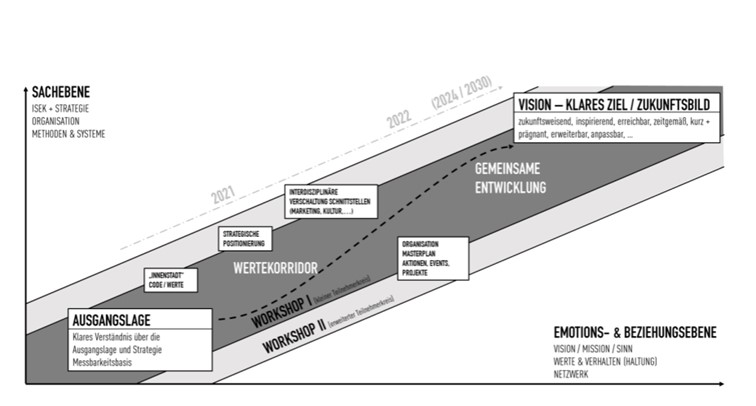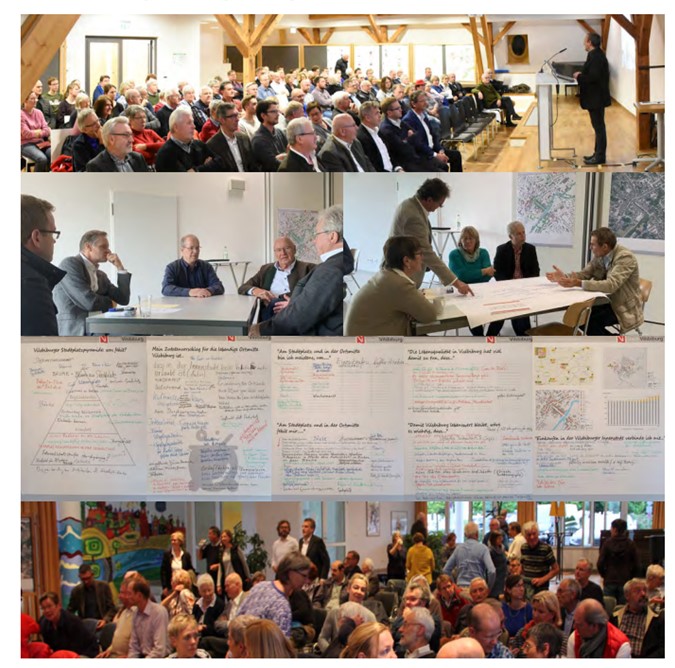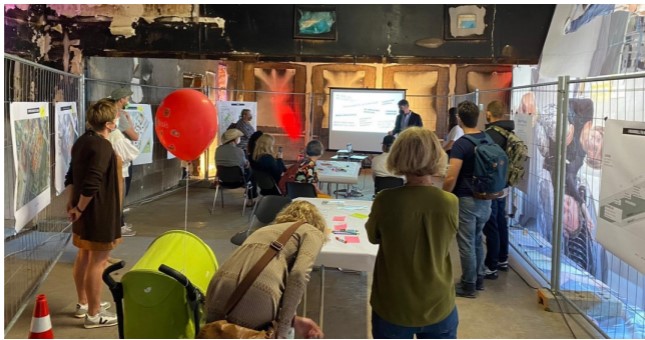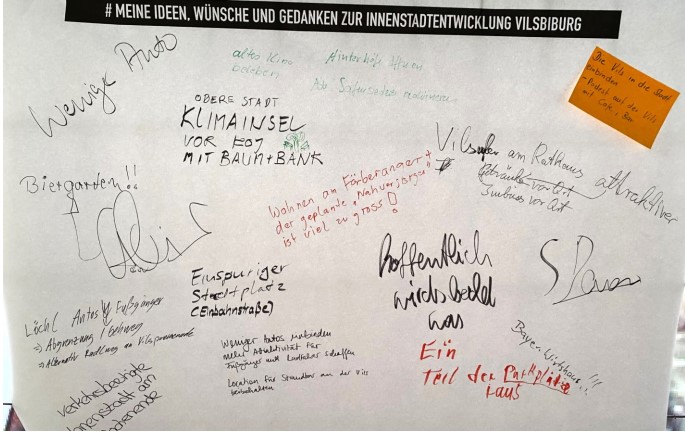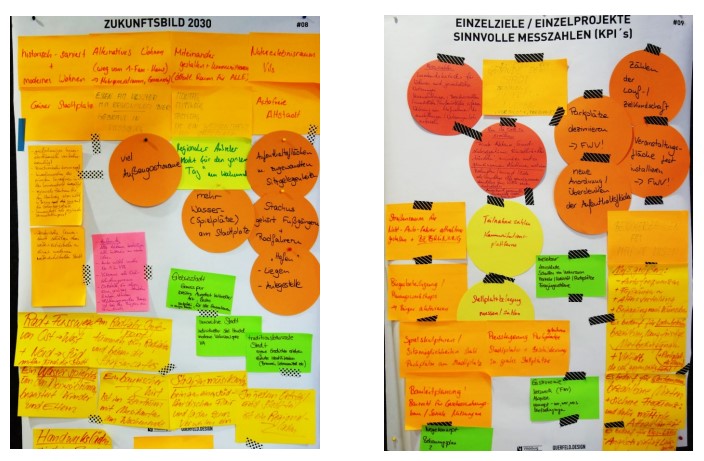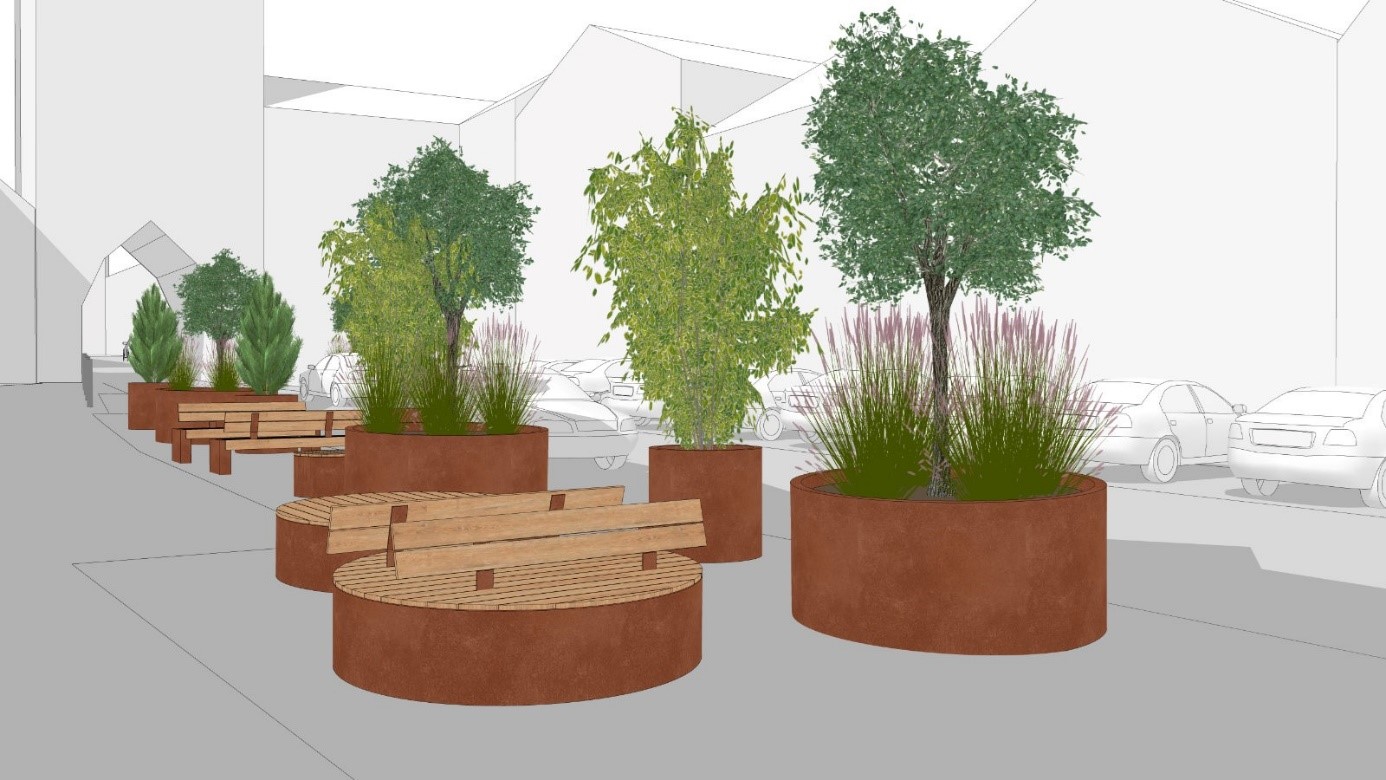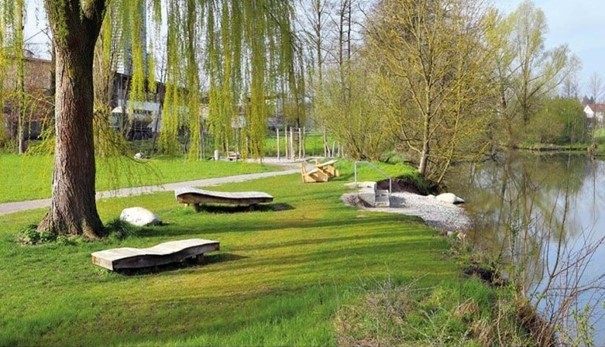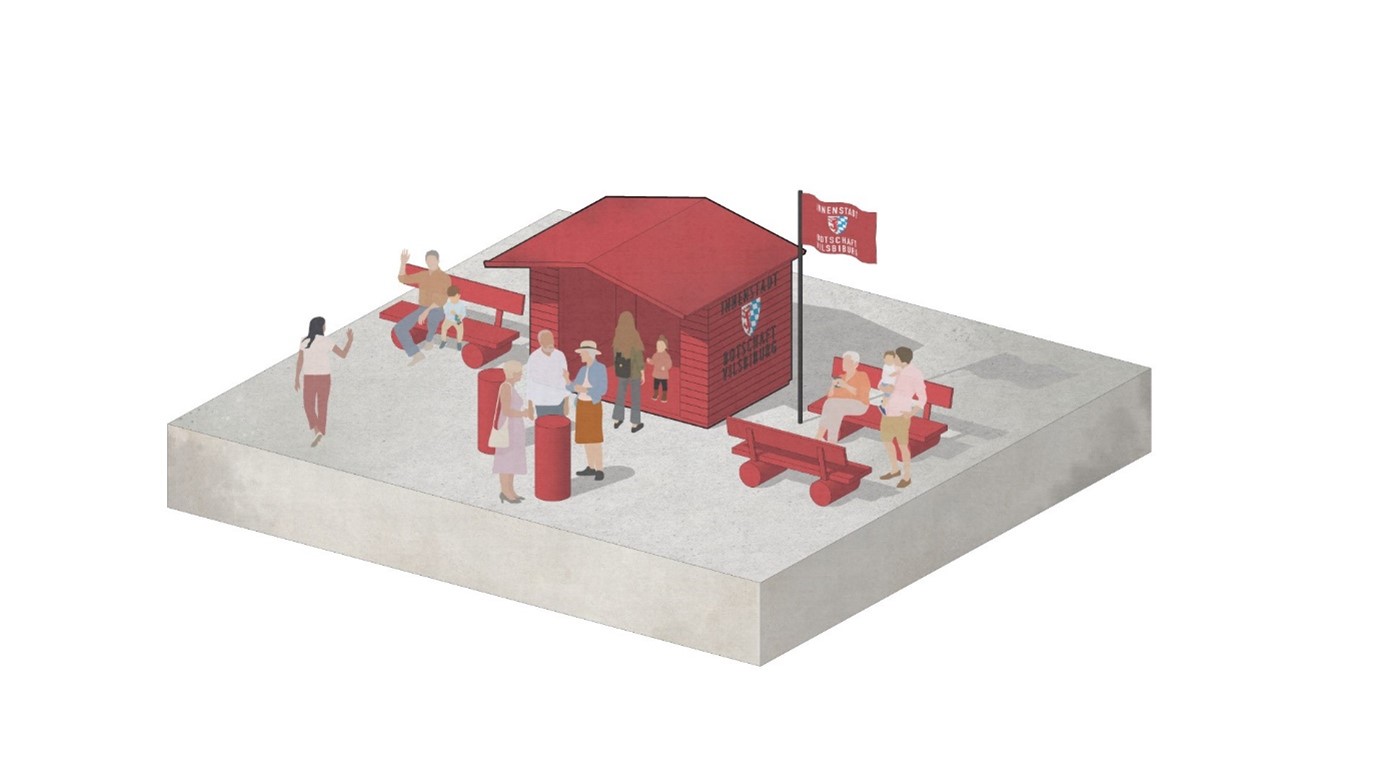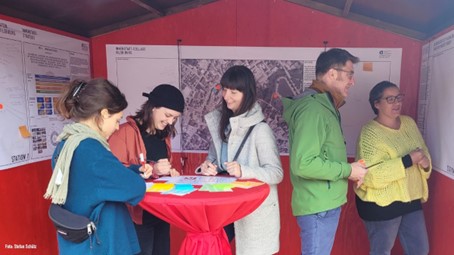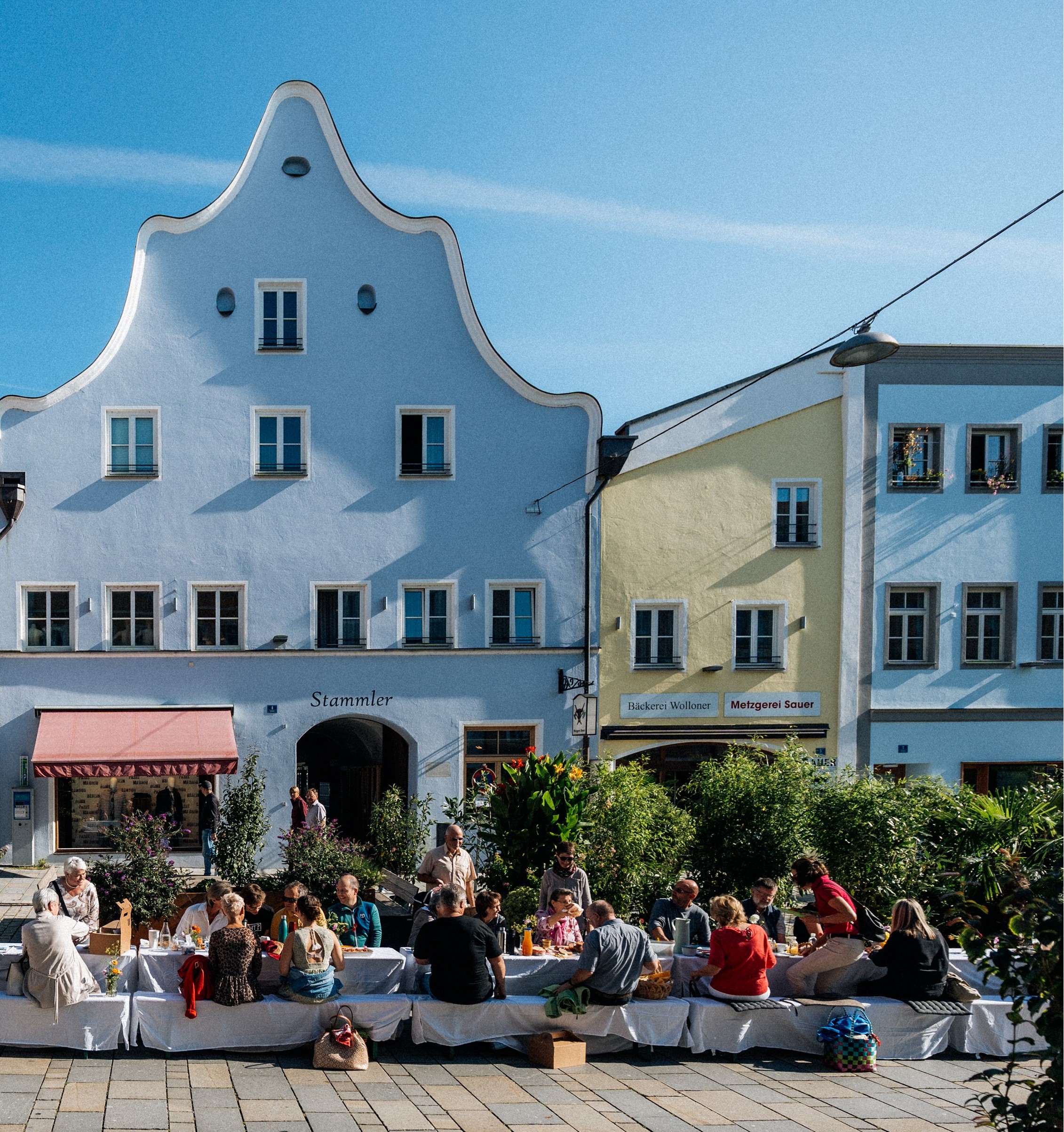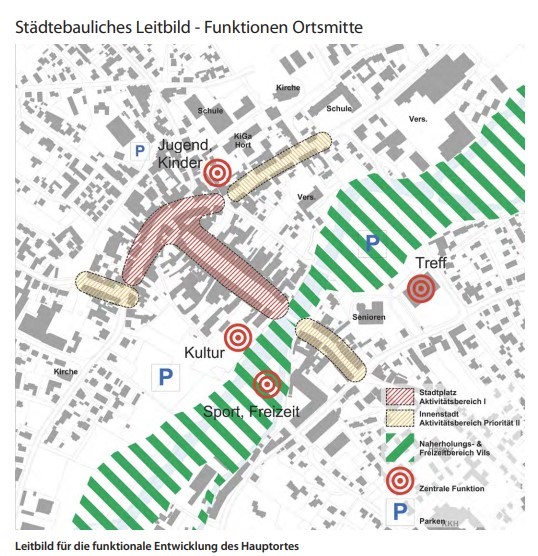Heritage meets Sustainable Innovation
Vibrant Vilsbiburg for all: Transforming Our Town Center for Sustainability and Inclusion
Vilsbiburg: A vibrant town center for all!
Vilsbiburg: Where heritage meets sustainable innovation! We are holisticly transforming the historic town center into a vibrant cultural and societal hub, blending heritage and future-forward design. Spaces emphasize accessibility, green infrastructure, and opportunities for all. Our initiative serves as a blueprint for European small towns.
Vilsbiburg: Where heritage meets sustainable innovation! We are holisticly transforming the historic town center into a vibrant cultural and societal hub, blending heritage and future-forward design. Spaces emphasize accessibility, green infrastructure, and opportunities for all. Our initiative serves as a blueprint for European small towns.
Germany
{Empty}
Prototype level
Yes
Yes
Yes
No
No
09274184: Vilsbiburg, St (DE)
The Vilsbiburg initiative revitalizes the town center through sustainable, inclusive, and aesthetically appealing development that fosters economic growth, social cohesion, and environmental sustainability. It targets residents, businesses, cultural organizations, and visitors with features like barrier-free buildings, accessible pathways, sensory-friendly areas, and recreational spaces for families and seniors.
Key objectives include creating eco-friendly, multi-purpose spaces for retail, residential, and cultural use. These buildings will incorporate energy-efficient materials, renewable energy, and sustainable water systems. Examples include the culture center and the multipurpose culture hall. Public areas, such as plazas, courtyards, and rooftop gardens, will foster community interaction. The mixed-use plaza "Freyung," combining apartments and stores, and the renovation of historic buildings like a brewery, will preserve local identity while ensuring full accessibility through universal design. A cooperative-operated brewery and inn will become a key social hub near the river Vils.
The initiative aims to create a vibrant, bustling town center with improved quality of life, expanded business opportunities, and stronger social networks. By fully embracing the New European Bauhaus values of sustainability, inclusivity, and beauty, Vilsbiburg will serve as a model for small-town development across Europe.
Key objectives include creating eco-friendly, multi-purpose spaces for retail, residential, and cultural use. These buildings will incorporate energy-efficient materials, renewable energy, and sustainable water systems. Examples include the culture center and the multipurpose culture hall. Public areas, such as plazas, courtyards, and rooftop gardens, will foster community interaction. The mixed-use plaza "Freyung," combining apartments and stores, and the renovation of historic buildings like a brewery, will preserve local identity while ensuring full accessibility through universal design. A cooperative-operated brewery and inn will become a key social hub near the river Vils.
The initiative aims to create a vibrant, bustling town center with improved quality of life, expanded business opportunities, and stronger social networks. By fully embracing the New European Bauhaus values of sustainability, inclusivity, and beauty, Vilsbiburg will serve as a model for small-town development across Europe.
Sustainability
Inclusivity
Architecture
Community
Innovation
The Vilsbiburg initiative revitalizes the town center through sustainable, inclusive, and aesthetically appealing development that fosters economic growth, social cohesion, and environmental sustainability. It targets residents, businesses, cultural organizations, and visitors with features like barrier-free buildings, accessible pathways, sensory-friendly areas, and recreational spaces for families and seniors.
Key objectives include creating eco-friendly, multi-purpose spaces for retail, residential, and cultural use. These buildings will incorporate energy-efficient materials, renewable energy, and sustainable water systems. Examples include the culture center and the multipurpose culture hall. Public areas, such as plazas, courtyards, and rooftop gardens, will foster community interaction. The mixed-use plaza "Freyung," combining apartments and stores, and the renovation of historic buildings like a brewery, will preserve local identity while ensuring full accessibility through universal design. A cooperative-operated brewery and inn will become a key social hub near the river Vils.
The initiative aims to create a vibrant, bustling town center with improved quality of life, expanded business opportunities, and stronger social networks. By fully embracing the New European Bauhaus values of sustainability, inclusivity, and beauty, Vilsbiburg will serve as a model for small-town development across Europe.
Key objectives include creating eco-friendly, multi-purpose spaces for retail, residential, and cultural use. These buildings will incorporate energy-efficient materials, renewable energy, and sustainable water systems. Examples include the culture center and the multipurpose culture hall. Public areas, such as plazas, courtyards, and rooftop gardens, will foster community interaction. The mixed-use plaza "Freyung," combining apartments and stores, and the renovation of historic buildings like a brewery, will preserve local identity while ensuring full accessibility through universal design. A cooperative-operated brewery and inn will become a key social hub near the river Vils.
The initiative aims to create a vibrant, bustling town center with improved quality of life, expanded business opportunities, and stronger social networks. By fully embracing the New European Bauhaus values of sustainability, inclusivity, and beauty, Vilsbiburg will serve as a model for small-town development across Europe.
Our initiative emphasizes aesthetics and quality of experience, transforming Vilsbiburg’s town center into a visually appealing, culturally rich, and engaging environment. A key objective is to create a cohesive public realm that blends traditional and modern elements, reflecting the town's heritage. Public spaces will feature high-quality materials, landscaping, and artistic installations, fostering an atmosphere that invites exploration and enjoyment.
We aim to enhance positive emotions by designing spaces that promote social interaction, relaxation, and recreation. Collaborations with local artists will integrate culturally significant public art, while sustainably sourced materials ensure architectural continuity. Gathering places such as plazas, promenades, and pedestrian-friendly streets will offer openness and welcome. Comfort and usability will be improved with seating, shade structures, and adaptable spaces for diverse activities.
The initiative strengthens cultural identity through local traditions and inclusive programming, including language-friendly signage, multicultural festivals, and partnerships with organizations supporting marginalized groups. Regular events like markets and performances will enrich social and cultural life.
By blending aesthetics, functionality, and cultural expression, the initiative shows how small towns can enhance residents’ and visitors' experiences. It demonstrates that urban design focused on beauty and well-being can elevate a town's appeal and strengthen its sense of place. This commitment to high-quality, inclusive design aligns with the New European Bauhaus vision of human-centered development.
We aim to enhance positive emotions by designing spaces that promote social interaction, relaxation, and recreation. Collaborations with local artists will integrate culturally significant public art, while sustainably sourced materials ensure architectural continuity. Gathering places such as plazas, promenades, and pedestrian-friendly streets will offer openness and welcome. Comfort and usability will be improved with seating, shade structures, and adaptable spaces for diverse activities.
The initiative strengthens cultural identity through local traditions and inclusive programming, including language-friendly signage, multicultural festivals, and partnerships with organizations supporting marginalized groups. Regular events like markets and performances will enrich social and cultural life.
By blending aesthetics, functionality, and cultural expression, the initiative shows how small towns can enhance residents’ and visitors' experiences. It demonstrates that urban design focused on beauty and well-being can elevate a town's appeal and strengthen its sense of place. This commitment to high-quality, inclusive design aligns with the New European Bauhaus vision of human-centered development.
Our initiative emphasizes inclusion by ensuring that the town center is accessible, affordable, and welcoming for all. The project adopts a universal design approach to provide barrier-free access to public spaces, buildings, and infrastructure. Key features include wide, accessible pedestrian paths, ramps, elevators, and sensory-friendly areas to support people with disabilities. These design elements ensure that all residents, regardless of age or ability, can fully engage in the town's cultural, social, and economic life.
The initiative also addresses affordability by promoting inclusive housing and community services. Mixed-use developments provide affordable housing options alongside commercial and cultural spaces, ensuring that a diverse range of residents can live and thrive in the town center. Public spaces, including plazas and recreational areas, are designed to remain free and open for everyone, encouraging social interaction across demographic and economic groups.
Inclusive governance is promoted through participatory decision-making. Citizens have been actively involved in shaping the initiative through consultations, workshops, and a youth advisory committee that ensures the voices of younger generations are represented. Partnerships with civil society organizations and social service providers further strengthen this inclusive governance model.
Cultural inclusion is fostered through multicultural festivals, community events, and collaborations with local artists to reflect the town's diverse identities. Programs include language-friendly signage and initiatives to support marginalized groups, enhancing integration and social cohesion. By integrating accessibility, affordability, and participatory governance, Vilsbiburg demonstrates how inclusive urban planning can promote equity and engagement. This commitment aligns with the NEB vision of creating spaces that foster belonging and opportunity for all, serving as an exemplary model for others.
The initiative also addresses affordability by promoting inclusive housing and community services. Mixed-use developments provide affordable housing options alongside commercial and cultural spaces, ensuring that a diverse range of residents can live and thrive in the town center. Public spaces, including plazas and recreational areas, are designed to remain free and open for everyone, encouraging social interaction across demographic and economic groups.
Inclusive governance is promoted through participatory decision-making. Citizens have been actively involved in shaping the initiative through consultations, workshops, and a youth advisory committee that ensures the voices of younger generations are represented. Partnerships with civil society organizations and social service providers further strengthen this inclusive governance model.
Cultural inclusion is fostered through multicultural festivals, community events, and collaborations with local artists to reflect the town's diverse identities. Programs include language-friendly signage and initiatives to support marginalized groups, enhancing integration and social cohesion. By integrating accessibility, affordability, and participatory governance, Vilsbiburg demonstrates how inclusive urban planning can promote equity and engagement. This commitment aligns with the NEB vision of creating spaces that foster belonging and opportunity for all, serving as an exemplary model for others.
Citizens and civil society play a central role in shaping and implementing the Vilsbiburg town center transformation initiative. From the project's inception, we have prioritized inclusive participation through workshops, public consultations, and co-design sessions. From project design workshops attended by over 500 residents to citizen advisory boards managing ongoing improvements, we have fostered deep participation at every stage. In particular, the view oft he future generation is included via an official youth comittee of teenagers and young adults. Local residents, business owners, youth groups, senior representatives, and community organizations have been actively engaged in defining the vision and strategic priorities for the town center. This process ensures that the initiative reflects the needs, aspirations, and values of those directly impacted by the changes.
Workshops and participatory events have provided a platform for stakeholders to propose ideas, voice concerns, and collaborate on design solutions. For example, citizens have contributed to the design of new gathering spaces, accessibility features, and sustainable infrastructure, ensuring these elements are practical and widely supported. Additionally, community groups have partnered with the municipality to organize events such as cultural festivals and educational activities aimed at promoting sustainability and local heritage.
Ongoing involvement is key to maintaining momentum. Citizens will continue to participate in decision-making through feedback sessions, user testing of new spaces, and advisory boards. A dedicated communication strategy, including newsletters, social media updates, and in-person forums, will keep the public informed and engaged throughout the project's implementation.
This participatory approach has strengthened trust between the municipality and its citizens, fostering a sense of ownership and pride in the initiative.
Workshops and participatory events have provided a platform for stakeholders to propose ideas, voice concerns, and collaborate on design solutions. For example, citizens have contributed to the design of new gathering spaces, accessibility features, and sustainable infrastructure, ensuring these elements are practical and widely supported. Additionally, community groups have partnered with the municipality to organize events such as cultural festivals and educational activities aimed at promoting sustainability and local heritage.
Ongoing involvement is key to maintaining momentum. Citizens will continue to participate in decision-making through feedback sessions, user testing of new spaces, and advisory boards. A dedicated communication strategy, including newsletters, social media updates, and in-person forums, will keep the public informed and engaged throughout the project's implementation.
This participatory approach has strengthened trust between the municipality and its citizens, fostering a sense of ownership and pride in the initiative.
The Vilsbiburg town center initiative has engaged stakeholders at local, regional, national, and European levels to ensure broad collaboration and success. Locally, the municipality has involved residents, business owners, civil society organizations, schools, and cultural institutions. Citizens have contributed through consultations, workshops, and public forums, while local businesses provided input to support economic growth and attract visitors.
Regionally, the initiative has partnered with neighboring municipalities, planning authorities, and development agencies to share knowledge on urban design, sustainability, and resource efficiency. Regional associations have also promoted Vilsbiburg as a model for similar towns.
At the national level, urban planning experts, architects, and governmental agencies have supported the initiative, particularly in areas like renewable energy, circular economy projects, and social inclusion. Their expertise has helped advance sustainable infrastructure and community-driven planning.
On the European level, the initiative aligns with New European Bauhaus values by collaborating with municipalities across Europe through cross-border exchanges and best-practice platforms. European experts have provided insights on sustainable mobility and universal design. The Silicon Vilstal Experience Festival, a key engagement event, earned "European Social Economy Region" (ESER) recognition, and its organizer, Silicon Vilstal, became the first official German partner of the New European Bauhaus Initiative.
This multi-level collaboration has enriched the initiative with diverse expertise, strong partnerships, and funding, resulting in a shared vision for Vilsbiburg as a vibrant, sustainable, and inclusive town center. It serves as a model for small urban centers across Europe.
Regionally, the initiative has partnered with neighboring municipalities, planning authorities, and development agencies to share knowledge on urban design, sustainability, and resource efficiency. Regional associations have also promoted Vilsbiburg as a model for similar towns.
At the national level, urban planning experts, architects, and governmental agencies have supported the initiative, particularly in areas like renewable energy, circular economy projects, and social inclusion. Their expertise has helped advance sustainable infrastructure and community-driven planning.
On the European level, the initiative aligns with New European Bauhaus values by collaborating with municipalities across Europe through cross-border exchanges and best-practice platforms. European experts have provided insights on sustainable mobility and universal design. The Silicon Vilstal Experience Festival, a key engagement event, earned "European Social Economy Region" (ESER) recognition, and its organizer, Silicon Vilstal, became the first official German partner of the New European Bauhaus Initiative.
This multi-level collaboration has enriched the initiative with diverse expertise, strong partnerships, and funding, resulting in a shared vision for Vilsbiburg as a vibrant, sustainable, and inclusive town center. It serves as a model for small urban centers across Europe.
The Vilsbiburg town center initiative integrates multiple disciplines and knowledge fields to ensure a comprehensive and innovative approach to urban transformation. Key fields include urban planning, architecture, landscape design, sustainability and environmental science, economics, and social innovation.
Urban planners and architects have collaborated to design functional, aesthetically pleasing public spaces that reflect the town's cultural identity. Landscape designers have contributed nature-based solutions to improve biodiversity and create green, climate-resilient spaces. Environmental experts have advised on sustainable infrastructure, energy efficiency, and circular economy practices to minimize the environmental footprint.
Economic experts have provided strategies to support local businesses, enhance the commercial appeal of the town center, and foster long-term economic vitality. Social scientists and community organizers have focused on fostering inclusion and citizen participation, ensuring that diverse groups are involved and their needs considered.
Representatives from these fields have interacted through interdisciplinary workshops, planning sessions, and collaborative working groups. This process encouraged a holistic view where technical, social, and environmental considerations were balanced. For example, architects worked with environmental specialists to design public spaces that both enhance aesthetics and promote sustainability. Similarly, economic experts collaborated with urban planners to ensure designs would attract business and foot traffic without compromising community needs.
This interdisciplinary approach added significant value by generating innovative, integrated solutions that address multiple objectives simultaneously. It ensured that the initiative is both practical and visionary, creating a vibrant town center that aligns with the New European Bauhaus principles of sustainability, inclusivity, and beauty.
Urban planners and architects have collaborated to design functional, aesthetically pleasing public spaces that reflect the town's cultural identity. Landscape designers have contributed nature-based solutions to improve biodiversity and create green, climate-resilient spaces. Environmental experts have advised on sustainable infrastructure, energy efficiency, and circular economy practices to minimize the environmental footprint.
Economic experts have provided strategies to support local businesses, enhance the commercial appeal of the town center, and foster long-term economic vitality. Social scientists and community organizers have focused on fostering inclusion and citizen participation, ensuring that diverse groups are involved and their needs considered.
Representatives from these fields have interacted through interdisciplinary workshops, planning sessions, and collaborative working groups. This process encouraged a holistic view where technical, social, and environmental considerations were balanced. For example, architects worked with environmental specialists to design public spaces that both enhance aesthetics and promote sustainability. Similarly, economic experts collaborated with urban planners to ensure designs would attract business and foot traffic without compromising community needs.
This interdisciplinary approach added significant value by generating innovative, integrated solutions that address multiple objectives simultaneously. It ensured that the initiative is both practical and visionary, creating a vibrant town center that aligns with the New European Bauhaus principles of sustainability, inclusivity, and beauty.
The Vilsbiburg town center initiative stands out for its innovative integration of sustainability, inclusivity, and aesthetics, surpassing mainstream urban revitalization efforts. The initiative pioneers multifunctional spaces integrating climate-resilient green infrastructure and cooperative business models, making it a groundbreaking example for holistic urban development inspired by the New European Bauhaus principles. It emphasizes co-creation with citizens, nature-based solutions, and circular economy practices as core elements from the start, rather than as add-ons.
A key innovation is the universal design strategy, ensuring that public spaces are accessible, adaptable, and welcoming to people of all ages and abilities. This contrasts with typical projects that may overlook comprehensive inclusivity. The initiative also promotes multifunctional spaces that blend retail, culture, and recreation, fostering a high "experience density" instead of focusing on isolated development sectors.
Moreover, the initiative leverages cross-sector collaboration by actively involving experts from various fields—urban planning, environmental science, and social inclusion—who work together in an interdisciplinary framework. It also applies cutting-edge green infrastructure, such as climate-resilient landscapes and pedestrian-first street designs, to enhance environmental sustainability.
The initiative’s participatory process, exemplified by the award-winning Silicon Vilstal Experience Festival, demonstrates an innovative model of societal engagement that positions Vilsbiburg as a trailblazer in small-town urban development.
A key innovation is the universal design strategy, ensuring that public spaces are accessible, adaptable, and welcoming to people of all ages and abilities. This contrasts with typical projects that may overlook comprehensive inclusivity. The initiative also promotes multifunctional spaces that blend retail, culture, and recreation, fostering a high "experience density" instead of focusing on isolated development sectors.
Moreover, the initiative leverages cross-sector collaboration by actively involving experts from various fields—urban planning, environmental science, and social inclusion—who work together in an interdisciplinary framework. It also applies cutting-edge green infrastructure, such as climate-resilient landscapes and pedestrian-first street designs, to enhance environmental sustainability.
The initiative’s participatory process, exemplified by the award-winning Silicon Vilstal Experience Festival, demonstrates an innovative model of societal engagement that positions Vilsbiburg as a trailblazer in small-town urban development.
The Vilsbiburg town center initiative applies a participatory, interdisciplinary, and sustainability-driven methodology to ensure holistic urban transformation. The approach is centered around co-creation and engagement, where stakeholders—including residents, businesses, and community organizations—are involved at every stage of the design and implementation process through workshops, forums, and feedback sessions. This ensures that the solutions reflect the needs and aspirations of those directly affected.
The initiative employs interdisciplinary collaboration, bringing together experts from urban planning, architecture, environmental science, landscape design, social inclusion, and economic development. These specialists work in coordinated teams to balance functional, aesthetic, and ecological goals. For example, urban planners and environmental experts collaborate on integrating climate-resilient green infrastructure, while social scientists ensure that public spaces are inclusive and accessible.
The project also prioritizes sustainability and circularity by embedding nature-based solutions, promoting sustainable mobility, and utilizing eco-friendly materials. This is supported by continuous monitoring and adaptive management to incorporate new insights and innovations over time.
A key feature of the approach is the iterative planning model, which allows for phased implementation, regular evaluation, and refinement of strategies based on community feedback and evolving urban needs. This dynamic, participatory, and future-oriented methodology exemplifies innovative urban planning aligned with New European Bauhaus values.
The initiative employs interdisciplinary collaboration, bringing together experts from urban planning, architecture, environmental science, landscape design, social inclusion, and economic development. These specialists work in coordinated teams to balance functional, aesthetic, and ecological goals. For example, urban planners and environmental experts collaborate on integrating climate-resilient green infrastructure, while social scientists ensure that public spaces are inclusive and accessible.
The project also prioritizes sustainability and circularity by embedding nature-based solutions, promoting sustainable mobility, and utilizing eco-friendly materials. This is supported by continuous monitoring and adaptive management to incorporate new insights and innovations over time.
A key feature of the approach is the iterative planning model, which allows for phased implementation, regular evaluation, and refinement of strategies based on community feedback and evolving urban needs. This dynamic, participatory, and future-oriented methodology exemplifies innovative urban planning aligned with New European Bauhaus values.
The Vilsbiburg initiative has been developed with replication and transferability in mind. It can be replicated or transferred to other towns, regions, and contexts:
The participatory co-creation model—which involves residents, businesses, and community groups in decision-making—can serve as a template for fostering stakeholder engagement and ownership in urban planning. This approach builds trust and ensures that projects reflect local needs and values.
The initiative’s focus on universal design and inclusive spaces can be applied in other communities to enhance accessibility and social integration. Similarly, the adoption of nature-based solutions, such as green infrastructure and climate-resilient landscapes, can be replicated to improve environmental sustainability and livability in various urban an rural contexts.
The interdisciplinary collaboration framework, where experts from different fields work together, offers a transferable model for integrating sustainability, economic development, and aesthetic improvements. Additionally, the iterative planning approach, which emphasizes continuous feedback and adaptation, can be used to maintain flexibility in urban development projects.
The Silicon Vilstal Experience Festival, as a tool for societal engagement and awareness, is another replicable element that showcases how cultural events can drive community involvement and innovation.
All these elements collectively form a robust, adaptable blueprint for sustainable, inclusive, and participatory urban regeneration.
Furthermore, Vilsbiburg and ist surrounding area have served as a societal living lab for numerous social innovation projects. The insights and transferrable blueprints derived from such projects have been showcased multiple times at European and global events like the „European Social Economy Region“ Conference and the „New European Bauhaus“ festival in Brussels or the global online event „Rural Design Days“.
The participatory co-creation model—which involves residents, businesses, and community groups in decision-making—can serve as a template for fostering stakeholder engagement and ownership in urban planning. This approach builds trust and ensures that projects reflect local needs and values.
The initiative’s focus on universal design and inclusive spaces can be applied in other communities to enhance accessibility and social integration. Similarly, the adoption of nature-based solutions, such as green infrastructure and climate-resilient landscapes, can be replicated to improve environmental sustainability and livability in various urban an rural contexts.
The interdisciplinary collaboration framework, where experts from different fields work together, offers a transferable model for integrating sustainability, economic development, and aesthetic improvements. Additionally, the iterative planning approach, which emphasizes continuous feedback and adaptation, can be used to maintain flexibility in urban development projects.
The Silicon Vilstal Experience Festival, as a tool for societal engagement and awareness, is another replicable element that showcases how cultural events can drive community involvement and innovation.
All these elements collectively form a robust, adaptable blueprint for sustainable, inclusive, and participatory urban regeneration.
Furthermore, Vilsbiburg and ist surrounding area have served as a societal living lab for numerous social innovation projects. The insights and transferrable blueprints derived from such projects have been showcased multiple times at European and global events like the „European Social Economy Region“ Conference and the „New European Bauhaus“ festival in Brussels or the global online event „Rural Design Days“.
The Vilsbiburg initiative addresses global challenges through locally adapted solutions. It tackles climate change by implementing nature-based solutions such as green infrastructure like the Balkspitz public nature resort, tree planting, mobile urban greenery at the town square and sustainable design to reduce heat islands, enhance biodiversity, and improve air quality. The building projects, that are part oft he initiative, have a strong focus on the conversion of existing building. E.g., the culture center will be converted from a former brewery.
These local actions contribute to climate resilience and global carbon reduction efforts.
The initiative also combats social inequality by promoting universal design and creating inclusive, accessible public spaces that welcome people of all ages and backgrounds. One example ist he social café in the city center. This fosters social cohesion and inclusion, addressing the global challenge of urban inequality.
To counteract economic decline in small towns, the initiative boosts local commerce and tourism by revitalizing the town center with multifunctional spaces (e.g. a planned coworking space) and cultural events, strengthening the local economy and providing a model for sustainable urban growth.
Additionally, it promotes sustainable urbanization through pedestrian-friendly streets, green mobility, and circular economy practices, reducing pollution and resource use. By engaging citizens in co-creation and decision-making, the initiative also addresses the need for more inclusive governance, empowering communities to shape their future.
These local actions contribute to climate resilience and global carbon reduction efforts.
The initiative also combats social inequality by promoting universal design and creating inclusive, accessible public spaces that welcome people of all ages and backgrounds. One example ist he social café in the city center. This fosters social cohesion and inclusion, addressing the global challenge of urban inequality.
To counteract economic decline in small towns, the initiative boosts local commerce and tourism by revitalizing the town center with multifunctional spaces (e.g. a planned coworking space) and cultural events, strengthening the local economy and providing a model for sustainable urban growth.
Additionally, it promotes sustainable urbanization through pedestrian-friendly streets, green mobility, and circular economy practices, reducing pollution and resource use. By engaging citizens in co-creation and decision-making, the initiative also addresses the need for more inclusive governance, empowering communities to shape their future.
The Vilsbiburg initiative’s next steps include constructing eco-friendly multi-purpose buildings, renovating existing structures, and expanding green infrastructure with plazas, gardens, and pedestrian-friendly zones to enhance sustainability. Improved cycling networks and renewable energy systems will support green mobility and resource efficiency. The initiative will also host cultural events and promote active use of public spaces to foster social cohesion.
NEB values have been incorporated through participatory design, with citizens contributing to planning via workshops, forums, and advisory boards. The project emphasizes universal design, ensuring spaces are inclusive and accessible for all. Collaborative efforts between architects, planners, environmental scientists, and community stakeholders reflect the transdisciplinary approach promoted by NEB.
Future steps include finalizing designs, implementing sustainable technologies, and conducting regular feedback sessions to adapt and improve. Partnerships with regional, national, and European stakeholders will provide knowledge-sharing and funding to achieve a vibrant, sustainable, and inclusive town center aligned with the New European Bauhaus principles.
NEB values have been incorporated through participatory design, with citizens contributing to planning via workshops, forums, and advisory boards. The project emphasizes universal design, ensuring spaces are inclusive and accessible for all. Collaborative efforts between architects, planners, environmental scientists, and community stakeholders reflect the transdisciplinary approach promoted by NEB.
Future steps include finalizing designs, implementing sustainable technologies, and conducting regular feedback sessions to adapt and improve. Partnerships with regional, national, and European stakeholders will provide knowledge-sharing and funding to achieve a vibrant, sustainable, and inclusive town center aligned with the New European Bauhaus principles.

